LRTA 1000 class
The LRTA 1000 class is the first-generation class of high-floor light rail vehicles (LRV) of the LRT Line 1.
Purchased under soft loans from the Belgian Government, the trains first entered service under the Light Rail Transit Authority (LRTA) in 1984. It has undergone two refurbishments; the first from 1999 to 2008, and the most recent by the Light Rail Manila Corporation (LRMC) from 2016 to 2017.
The newer 13000 class trains have gradually replaced the older 1000 class trains since 2023.
| LRTA 1000 class | |
|---|---|

A 1000 class train at Carriedo station in 2023
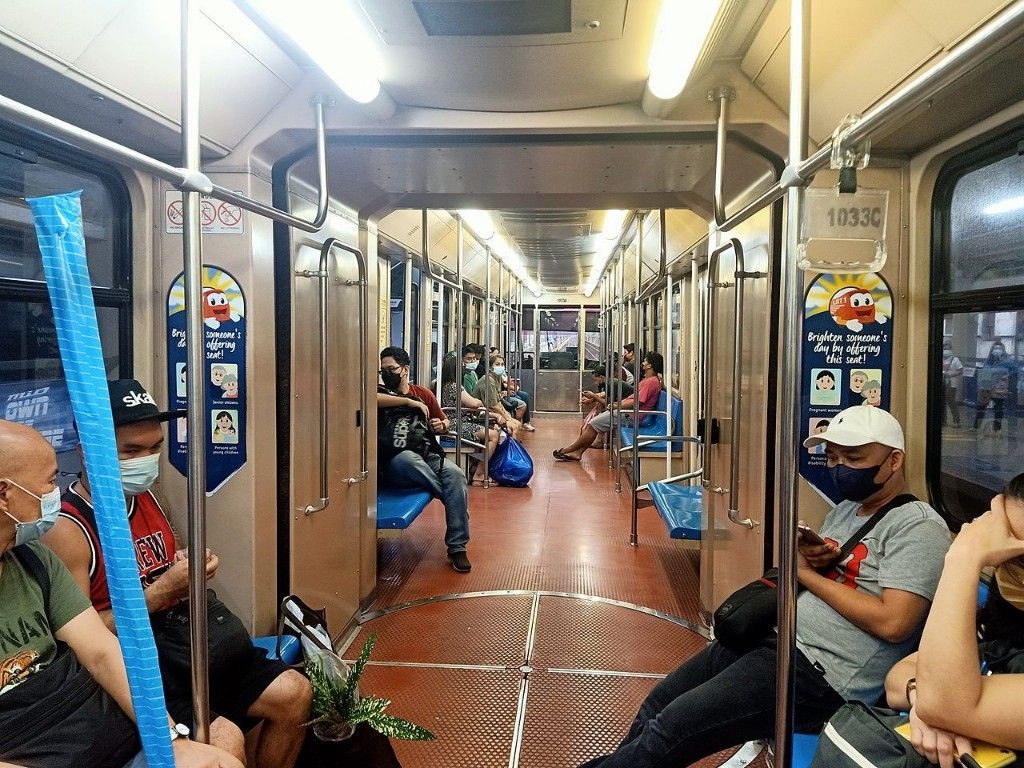
Interior of 1000 class LRV (first refurbishment) with new onboard equipment installed during the 2022 signalling upgrade.
|
|
| Stock type | Light rail vehicle |
| In service | 1984–present |
| Manufacturer |
BN Constructions Ferroviaires et Métalliques[note 1]
Ateliers de Constructions Electriques de Charleroi[note 2] |
| Assembled at | Bruges, Belgium |
| Constructed | 1982–1983 |
| Entered service | December 1, 1984 |
| Refurbished | 1999–2001
2003–2008 2016–2017 |
| Scrapped | 2000 |
| Number built | 64 vehicles (32 sets, initially 2-car sets) |
| Number in service | 26 vehicles |
| Number scrapped or decommissioned | 38 vehicles |
| Successor | 13000 class |
| Formation | 2–3 cars per trainset |
| Fleet numbers | 1001–1064 |
| Capacity | 748–1,122 passengers |
| Operator(s) |
|
| Depot(s) | Baclaran |
| Line(s) served | LRT Line 1 |
| Specifications | |
| Car body construction | BI sheet/copper-clad steel |
| Train length |
2-car trainset: 59.59 m
3-car trainset: 89.37 m |
| Car length | 29.79 m[note 3] |
| Width | 2.5 m |
| Height | As built: 3.272 m Refurbished: 3.525 m |
| Floor height | 900 mm |
| Platform height | 690 mm |
| Entry | Step |
| Doors | 5 sets of 1.3 m double-leaf plug door per side[note 4] |
| Articulated sections | 3 per PRV |
| Wheel diameter | 660 mm (new) |
| Wheelbase |
Per bogie:
1.9 m (motor bogies) 1.8 m (trailer bogies) Bogie centers: 6.75 m on cab ends 7.5 m between trailer bogies Total (end-to-end): 21 m |
| Maximum speed | 60 km/h |
| Weight |
Unrefurbished: 41 t
Refurbished: 46 t |
| Axie load | 9 t |
| Steep gradient | 4% |
| Traction system | ACEC thyristor chopper |
| Traction motors | 2 × 217.7 kW DC series-wound motor |
| Power output |
Per LRV: 435.4 kW
2-car trainset: 870.8 kW 3-car trainset: 1.31 MW |
| Transmission | Right-angle link drive |
| Acceleration | 1.0 m/s² |
| Deceleration |
Service: 1.3 m/s²
Emergency: 2.08 m/s² |
| Auxiliaries | Static converter |
| HVAC |
Forced ventilation; 12 units per LRV (1984–2008)
Roof-mounted duct-type air conditioning; 5 units per LRV (2004–present) |
| Electric system(s) | 750 V DC overhead catenary |
| Current collector(s) | Schunk single-arm pantograph |
| UIC classification | Bo′+2′+2′+Bo′ |
| Wheels driven | 8 out of 16 per LRV |
| Bogies | Inside-frame type |
| Minimum turning radius | 25 m |
| Breaking system(s) |
WABCO electro-pneumatic, regenerative, and rheostatic
Bogie-mounted disc and track brakes |
| Safety system(s) |
ATS (1984–2007)
ATP (2007–present; for active trains) |
| Coupling system(s) | Semi-permanent |
| Multiple working | Within type |
| Seating | Longitudinal |
| Track gauge |
1,435 mm
Standard track gauge |
Purchased under soft loans from the Belgian Government, the trains first entered service under the Light Rail Transit Authority (LRTA) in 1984. It has undergone two refurbishments; the first from 1999 to 2008, and the most recent by the Light Rail Manila Corporation (LRMC) from 2016 to 2017.
The newer 13000 class trains have gradually replaced the older 1000 class trains since 2023.
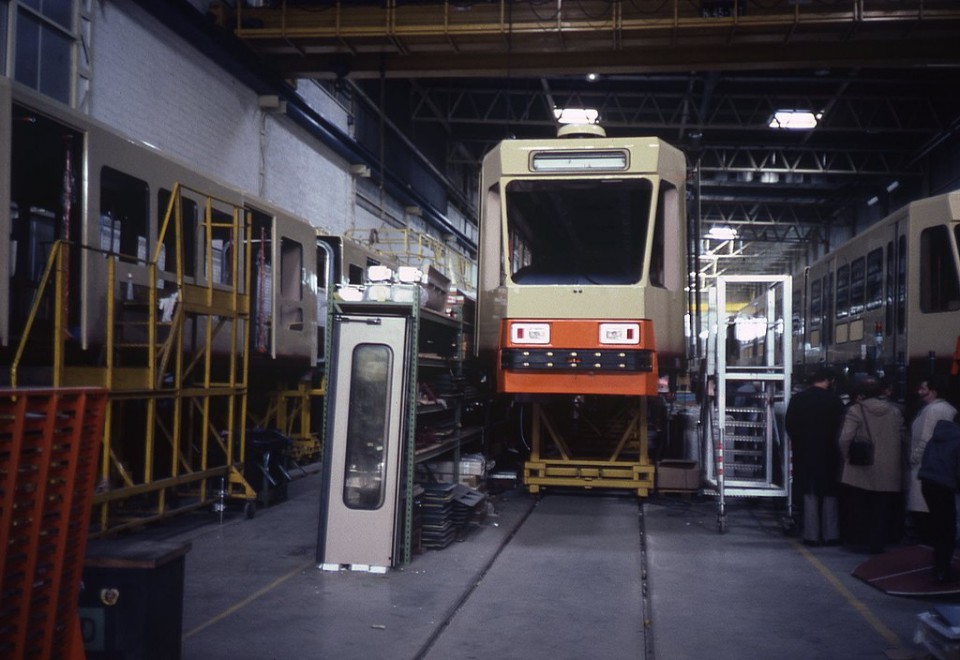
LRTA 1000 class LRVs under construction in the BN plant in Bruges, Belgium
Purchase
The construction of the original 15-kilometer section of the LRT Line 1 was funded by a ₱300 million soft and interest-free loan from the Belgian Government. Additional funding for the project was later sourced from a ₱700 million loan provided by the consortium of ACEC (Ateliers de Constructions Electriques de Charleroi), BN (Constructions Ferroviaires et Metalliques, formerly Brugeoise et Nivelles), TEI (Tractionnel Engineering International), and TC (Transurb Consult). The trains were included in the second loan package, along with the power systems, signaling, and telecommunications.Production and initial operations
The trains were manufactured by BN (now Bombardier Transportation Belgium S.A.), while the electrical equipment supplied were from ACEC. A total of 64 trains were built between 1982 and 1983.In its early stages, these trains ran on a two-car configuration until 1999, when it was upgraded to three cars. However, not all of the train cars are capable to be coupled to form three-car sets.
First refurbishment
From 1999 to 2001, 32 LRVs underwent the first refurbishment, carried out by BN, ACEC Transport SA, Transurb Consult, and Tractebel. The car body was repaired and a new livery design was added. Seats were also replaced, new components were installated, and modifications were made on the roof for the installation of air conditioning units. Replacement and cleaning of electrical components were not included.The 31 remaining LRVs that were not modernized in Phase 1 underwent refurbishment by the Light Rail Transit Authority from 2004 to January 2008. This involved the replacement of the electrical components of the trains, along with additional works in the 32 refurbished LRVs.
Second refurbishment
In September 2012, the then-Department of Transportation (DOTr) and the Light Rail Transit Authority (LRTA) announced a ₱203 million rehabilitation program for twenty-one first-generation vehicles.After the Light Rail Manila Corporation (LRMC) took over the operations and maintenance of Line 1 in 2015, the company initiated the second refurbishment of the trains in 2016 worth ₱1 billion. LRMC contracted Joratech Corporation to rehabilitate forty-six LRVs. These underwent removal of rust from the car body, repainting, replacement of flooring, and installation of new LED lightings and onboard signaling systems.
As of April 2022, 46 light rail vehicles underwent the second refurbishment.
Themed trains
By 2016, LRMC began placing special themed decorations in the 1000 class trains. These include the yearly Christmas and Valentine's-themed trains, special COVID-19 pandemic and vaccination-themed decorations, and a Gabay Guro themed train for teachers.Retirement
The first-generation 1000 class trains are planned to be replaced with the newer 13000 class fourth-generation trains.As of 2021, there are eight decommissioned 1000 class LRVs from accidents, cannibalized trains and 1037, involved in a terrorist attack. These were previously stored at the LRT Line 1 Baclaran Depot until these were transferred to the LRT Line 2 Santolan Depot due to the expansion of the former, and the last known train to be operated was seen on February 7, 2025, as a school train.
The LRV design is an 8-axle rigid body consisting of three articulated cars. It is the only 8-axle light rail vehicle in the entire rolling stock of the LRT Line 1, as subsequent trains since 1999 were built to the 6-axle design.
Car body
The 1000 class trains are made of BI sheet, sporting a white body livery with blue and yellow cheatlines. Prior to the first refurbishment, the 1000 class wore an orange and cream-white livery under the "Metrorail" branding, and notably had "mushroom-cap" roof-mounted ventilation.Prior to the 2003 refurbishment, each light rail vehicle had 12 roof-mounted forced ventilation units. A refurbished light rail vehicle has five roof-mounted air-conditioning units.
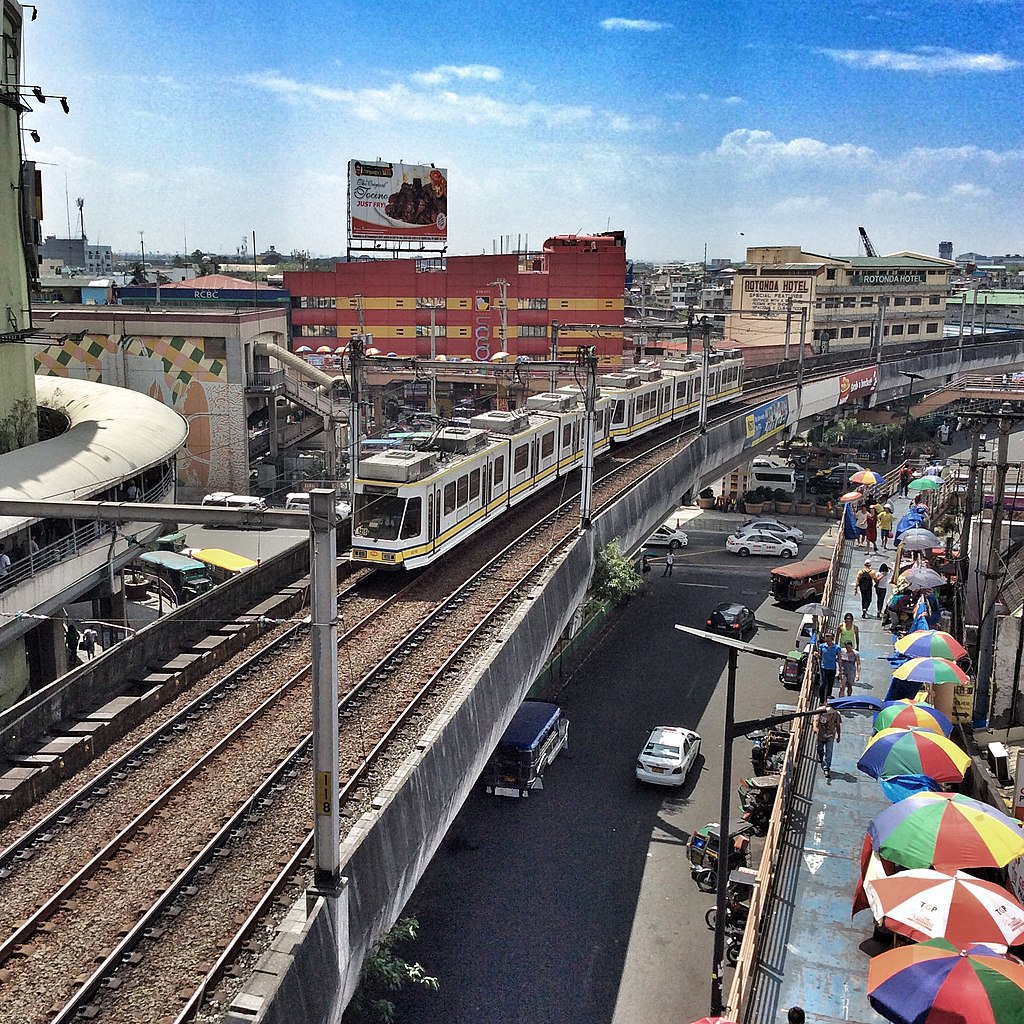
A two-car 1000 class train approaching EDSA station
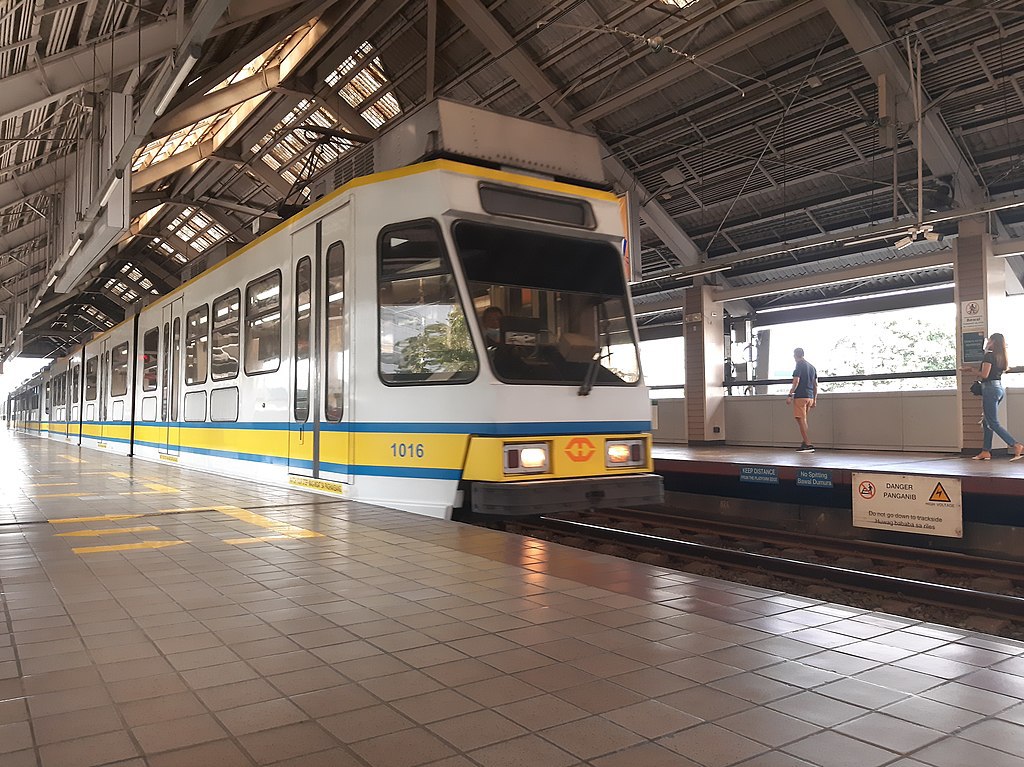
A 1000 class train approaching United Nations station
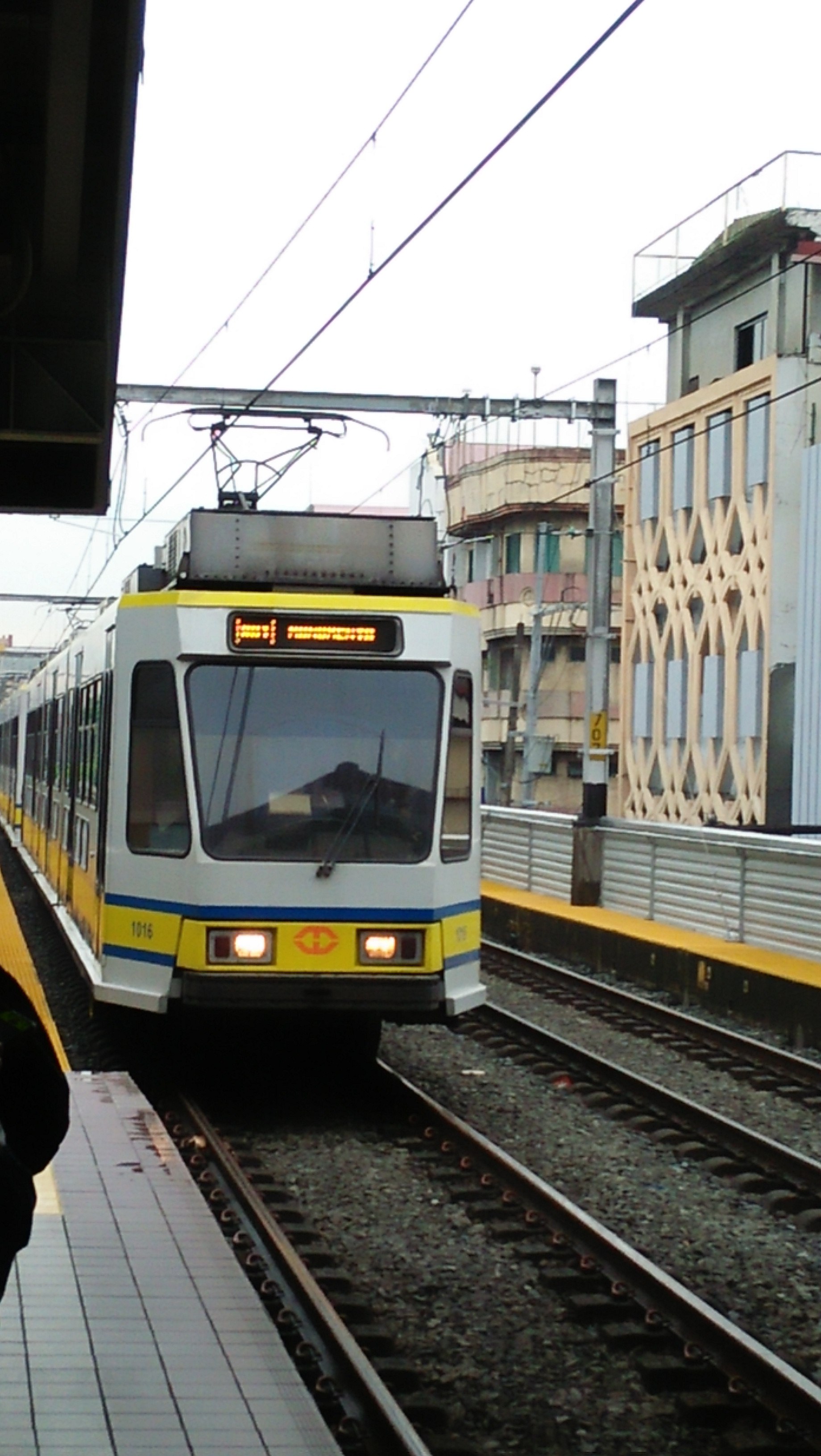
A newly refurbished 1000 class LRV with an LED destination front display
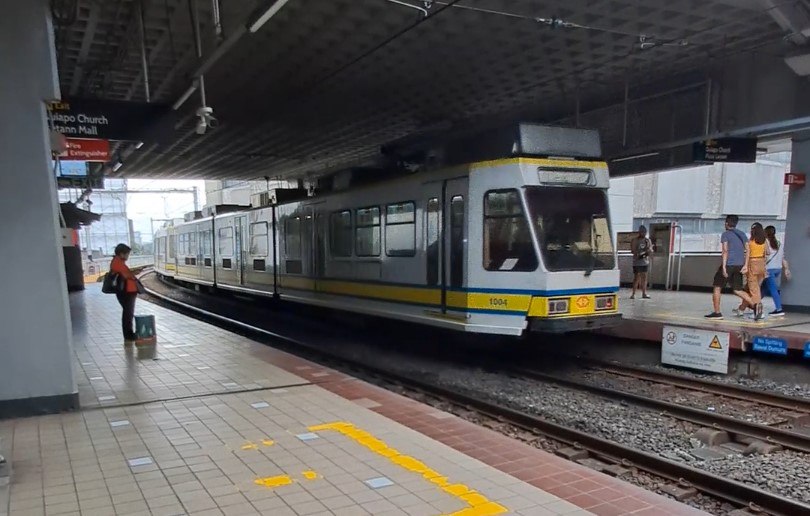
A 1000 class
train at Carriedo station
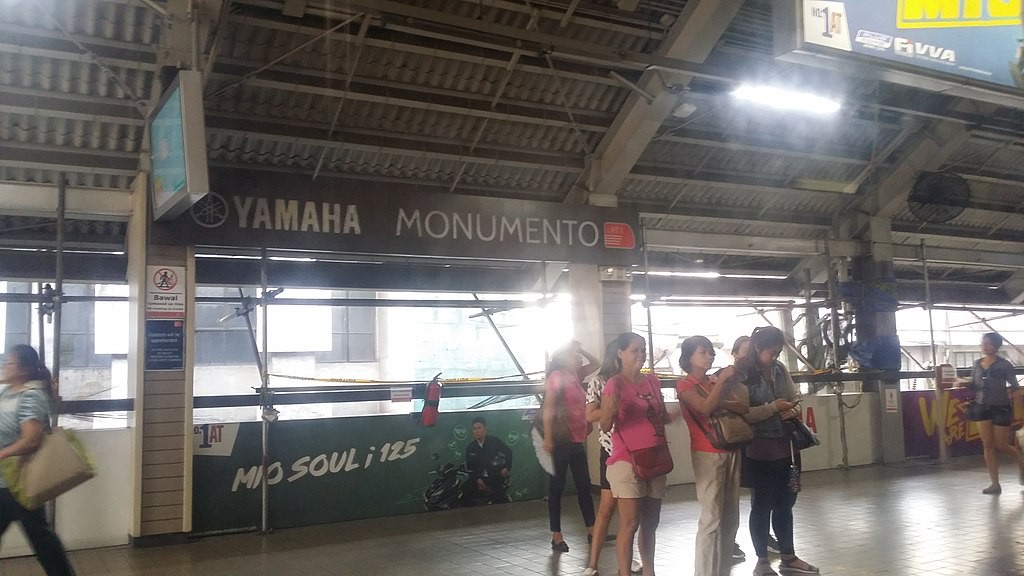
A three-car 1000 class train at Monumento station
Interior
Each LRV has five door swing plug-type doors per side. Each train car has a capacity of 81 seated passengers and 293 standing passengers, carrying a total of 374 passengers. Seats are colored blue and are longitudinal-type.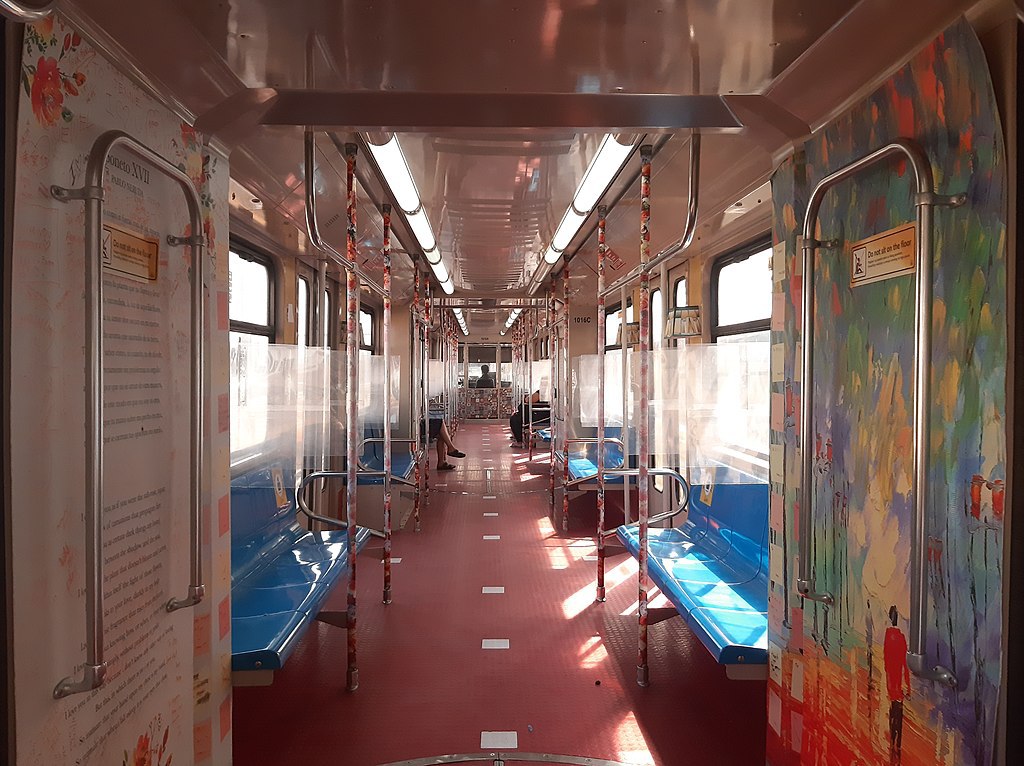
Interior of 1000 class LRV (first refurbishment)
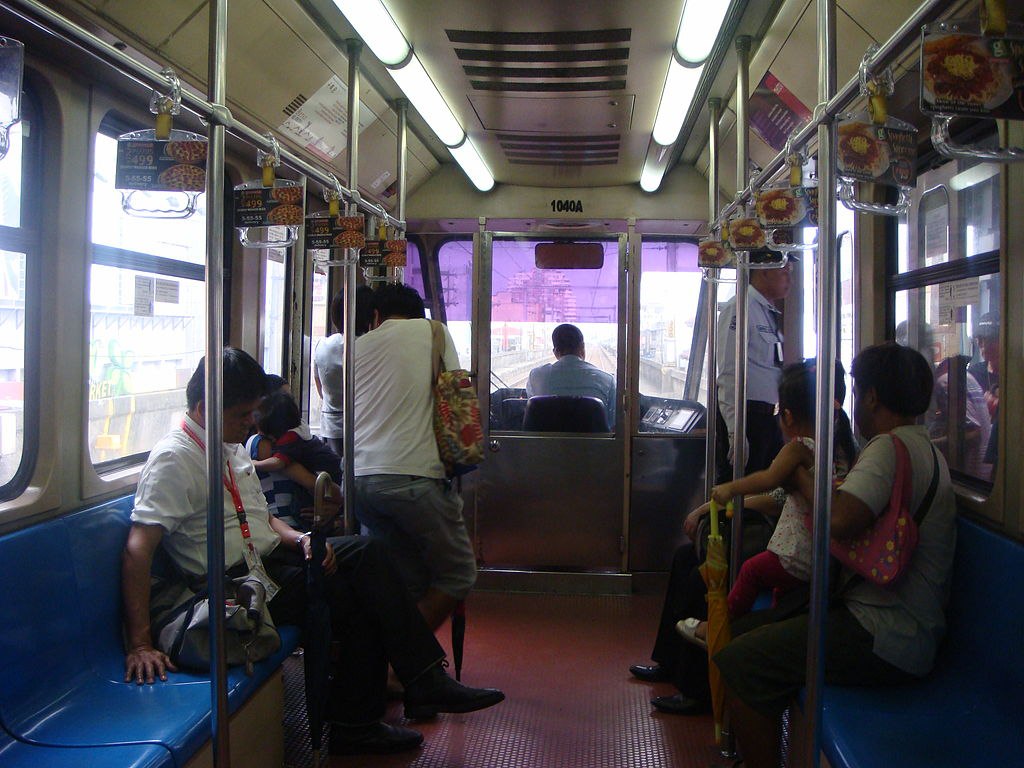
Interior of 1000 class LRV (second refurbishment)

Interior with new Alstom signaling equipment on the left.
Electrical and mechanical
A thyristor chopper traction control system is installed in the trains, powering two direct current (DC) straight-wound traction motors. Ateliers de Constructions Electriques de Charleroi (ACEC) manufactured the electrical and traction equipment for the trains.Each LRV has four inside-frame bogies consisting of two motorized bogies at the ends of the LRV and two trailer bogies under the articulations. The primary suspension is a conical rubber, while the secondary suspension is a coil spring. Semi-permanent couplers are present at the ends of the non-cab section (section B) of the light rail vehicles.
Braking system
Dynamic brakes are used as a service brake. There are two disc brakes per trailer bogies acting as a service brake and two disc brakes per motor bogies used as an emergency and substitution brake. Each bogie has two electromagnetic track brakes for use in case of emergency.The transmission is a bogie-mounted transmission consisting of a right-angle link drive transmitted via gears and two elastic couplings.
Each unidirectional light rail vehicle consists of three articulated cars.
| Car designation | A | B | C | |
|---|---|---|---|---|
| Control cab | Yes | No | No | |
| Motor | Yes | No | Yes | |
| Pantograph | Yes | No | No | |
| Car length | 31.72 m | |||
| Capacity | Seated | 81 | ||
| Standing | 293 | |||
| Total | 374 | |||
Original configurations of two-car trains.
Legend
| Either out of service, scrapped, or decommissioned |
| Set no. | 1 | 2 |
|---|---|---|
| 1 | 1001 | 1002 |
| 2 | 1003 | 1004 |
| 3 | 1005 | 1006 |
| 4 | 1007 | 1008 |
| 5 | 1009 | 1010 |
| 6 | 1011 | 1012 |
| 7 | 1013 | 1014 |
| 8 | 1015 | 1016 |
| 9 | 1017 | 1018 |
| 10 | 1019 | 1020 |
| 11 | 1021 | 1022 |
| 12 | 1023 | 1024 |
| 13 | 1025 | 1026 |
| 14 | 1027 | 1028 |
| 15 | 1029 | 1030 |
| 16 | 1031 | 1032 |
| 17 | 1033 | 1034 |
| 18 | 1035 | 1036 |
| 19 | 1037 | 1038 |
| 20 | 1039 | 1040 |
| 21 | 1041 | 1042 |
| 22 | 1043 | 1044 |
| 23 | 1045 | 1046 |
| 24 | 1047 | 1048 |
| 25 | 1049 | 1050 |
| 26 | 1051 | 1052 |
| 27 | 1053 | 1054 |
| 28 | 1055 | 1056 |
| 29 | 1057 | 1058 |
| 30 | 1059 | 1060 |
| 31 | 1061 | 1062 |
| 32 | 1063 | 1064 |
- On December 30, 2000, Rizal Day, a train (car number 1037) exploded at Blumentritt station as part of a series of explosions in a terrorist attack known as the Rizal Day bombings. The attack on Line 1 killed some 22 people and injured hundreds. The damaged train was decommissioned immediately after the incident. No confirmed plans were announced on its ultimate fate, whether it would be restored or scrapped. The train, together with other trainsets involved in accidents, have been ultimately sold for scrap.
- On June 24, 2010, two trains (1000 and 1200 class) collided at Balintawak station.
- On February 18, 2011, two trains (1000 and 1200 class trains) collided near Roosevelt Station in Quezon City on Friday at the reversing tracks, around a kilometer away to the east. No passengers were injured. This caused the Roosevelt and Balintawak stations to remain closed for two months until the stations were reopened on April 11, 2011. An investigation was conducted and was shown that one of the drivers was texting when the incident occurred. As a result, LRV 1015 sustained damage.
- On May 23, 2015, thousands of passengers were stranded after a train of Line 1 slammed into another train near the Monumento station. A train driver was hurt after the impact caused his head to slam into the dashboard of the train. The accident, later revealed to be caused by power fluctuation that affected the signalling system, forced passengers to alight from the station until services was restored around 1:00 PM at the same day.
- On March 10, 2016, a door in a 1st generation train car was left open while running between Central Terminal and Pedro Gil stations. The problem was fixed at the Pedro Gil station.
- On March 22, 2016, the doors of a 1st generation train car at the Central Terminal station failed to open, leaving passengers trapped inside the train.
- On September 26, 2016, a faulty door in a 1st generation train car suddenly slammed shut in less than a second. No one was injured.
- On September 26, 2018, a faulty 1st generation train door was unable to open at the Balintawak station. A passenger pushed the door open and was able to disembark. The next passenger pushed the door though it abruptly closed on him but managed to get through.
- On November 6, 2020, a 1st generation train car emitted smoke at Gil Puyat station at 2:00 PM due to a catenary fault. Passengers were evacuated, and the line implemented a provisional service from Balintawak to Central Terminal and vice versa. The situation normalized at 8:00 PM.